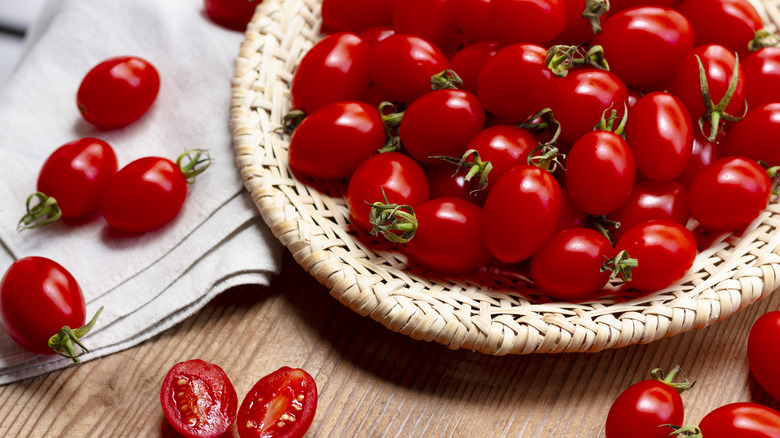Use A Splash Of This Pantry Staple To Give Cherry Tomatoes A Vibrant Boost
Before beefsteak and Brandywine tomatoes flood the farmer's market each year, you can always count on cherry tomatoes. These tiny, tasty treats can do anything a full-size tomato can do, from sauces to soups, and they're even great as a snack all on their own. Not every cherry tomato will have a big burst of flavor, however, especially when they've traveled a great distance to get to your salad bowl. If you have a basket of cherry tomatoes that are a little ho-hum, don't settle for a flat flavor. All you need to give them a vibrant boost is a splash of red wine vinegar, which is a staple in most kitchens.
The secret to using red wine to enhance cherry tomatoes is its acidity. Tomatoes typically have a lot of natural acid, but as they ripen and age, the acid levels can drop, and the flavor can change. A dash of red wine vinegar will enhance the tomatoes' natural umami flavors and bring the acidity back up so that they taste fresh and fruity once again.
Marinate cherry tomatoes in red wine vinegar
In most parts of the U.S., cherry tomatoes are ready for harvest as soon as mid-July, but you can usually buy a pint year-round thanks to indoor growing and importing. The problem with year-round cherry tomatoes, however, is that they aren't harvested at the peak of ripeness when acidity and sweetness are balanced. A splash of red wine vinegar can easily fix that, but the trick is to give the vinegar enough time to work a little flavor magic. All you have to do is marinate your cherry tomatoes before you eat or serve them, and you only need a couple of minutes. Chef Clare de Boer, for instance, told the New York Times in 2019 that her husband marinates tomatoes in a splash of red wine vinegar, olive oil, and salt for BLT sandwiches during the time it takes to cook the bacon. "This turns the dreariest tomato into a fantasy of San Marzano," she said.
Adding red wine vinegar to cherry tomatoes works to bring out the flavors of the fruit in a couple of ways. First, the acid in the vinegar balances out the overall flavor profile and enhances the sweet, fruity flavors. Red wine vinegar brings a little more to the party than, say, white wine vinegar, which also has plenty of acid. While you can use any vinegar on cherry tomatoes, red wine vinegar adds tannic bitterness, which your palate will register as complexity.
Red wine vinegar works in lots of tomato dishes
Balsamic vinegar gets all the press when it comes to tomato dishes, but the real MVP is regular red wine vinegar (and no, they're not the same thing). You'll probably see it listed over and over again in tomato-centric recipes because chefs and recipe developers know how it can seriously upgrade a tomato dish. In fact, you can add a splash of this kitchen staple any time you're using cherry tomatoes — or any tomatoes for that matter — and get a little boost of vibrancy.
If you've got cherry tomatoes that need a bit of a lift, there are a lot of chances to add red wine vinegar. If the tomatoes will be served fresh, marinate them in vinegar and oil like Clare de Boer's husband, or make a vinaigrette with red wine as the base ingredient. If you're cooking up a cherry tomato sauce, toss the tomatoes with red wine and olive oil before they're cooked, use red wine vinegar to deglaze the pan, or add a splash at the end when it's time to purée — or a combination of all three. If you're not sure how much red wine vinegar to use, stick to a tablespoon or two to start. The nice thing about cherry tomatoes is that they're the perfect size for tasting, so you can try dipping just a single tomato in the sour stuff before you scale the vinegar up to any full-sized recipe.


